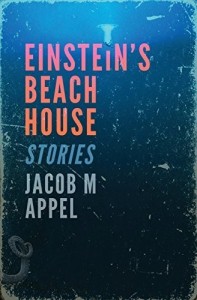188 pages, $15.95
Review by Lynne Weiss
The theme of the highly readable and surprising stories that comprise Jacob M. Appel’s Einstein’s Beach House is aptly expressed in the first sentence of the first story, “Hue and Cry”—these stories describe things that are “funny” when they happen “to other people.” Things, the narrator goes on to explain, like “tarring and feathering, Peeping Toms, mad cow disease.” In a sense, all three of these things happen to characters in this first story, which describes the plans of a man dying of a brain-wasting disease to teach his daughters forgiveness by taking them to meet a paroled Level 1 sex offender who has recently moved into their neighborhood. The protagonist is 13-year-old Lizzie, one of the aforementioned daughters of the dying man. While everyone else in the neighborhood is protesting the presence of the parolee (metaphorically tarring and feathering him), Lizzie’s father is making plans to befriend him, and Lizzie and her friend Julia are the Peeping Toms who put a watch on the sex offender’s house and break into it to look for something unspecified. “We’ll know it when we find it,” Julia assures Lizzie, and Lizzie does find something in the course of the story, but it has nothing to do with the sex offender and much to do with her coming to terms with her father’s death and declining powers.
Appel is an award-winning writer whose work has appeared in more than 200 literary journals. According to his website, Appel is has an M.D. from Columbia and has been admitted to the bar in New York State and Rhode Island. Einstein’s Beach House, which is published by Pressgang, a small press affiliated with the Butler University MFA program, is Appel’s second collection of short stories. He has also published novels and collections of essays. Continue reading
![[PANK]](http://pankmagazine.com/wp-content/themes/pank/assets/images/pank-logo-large.png)


